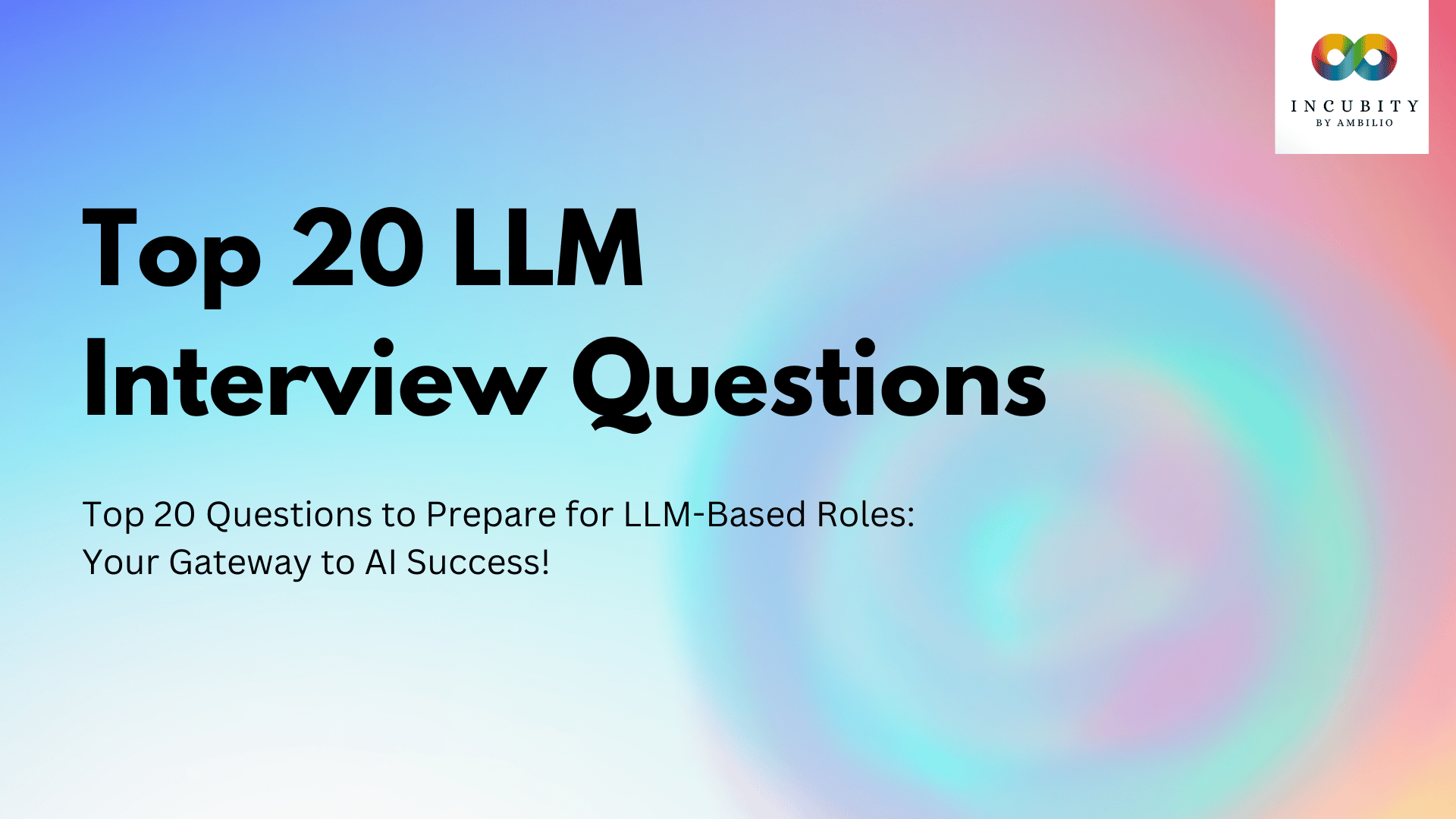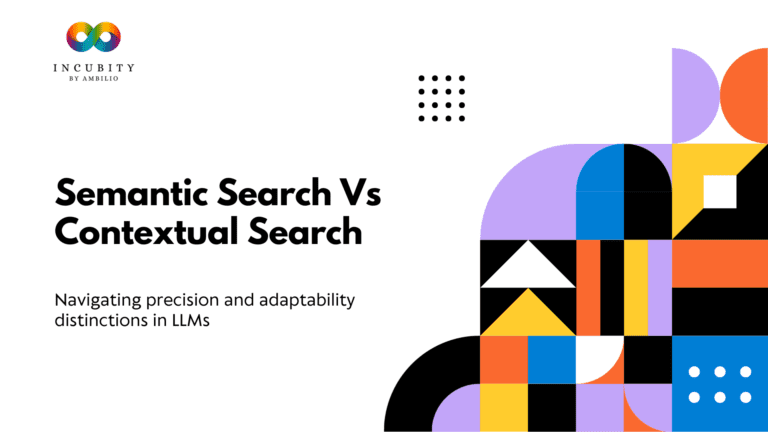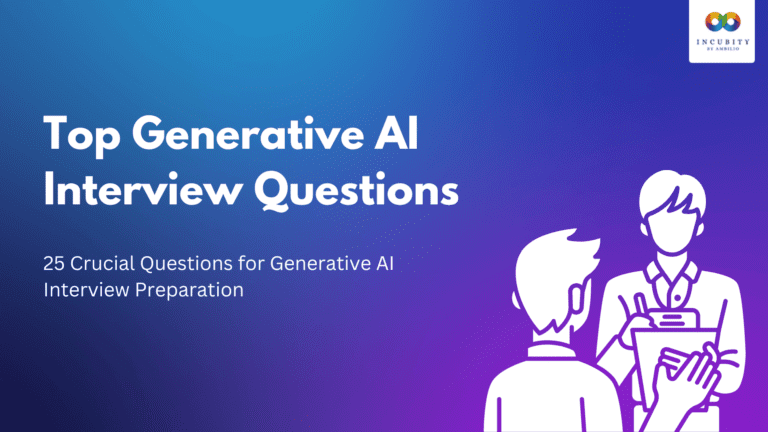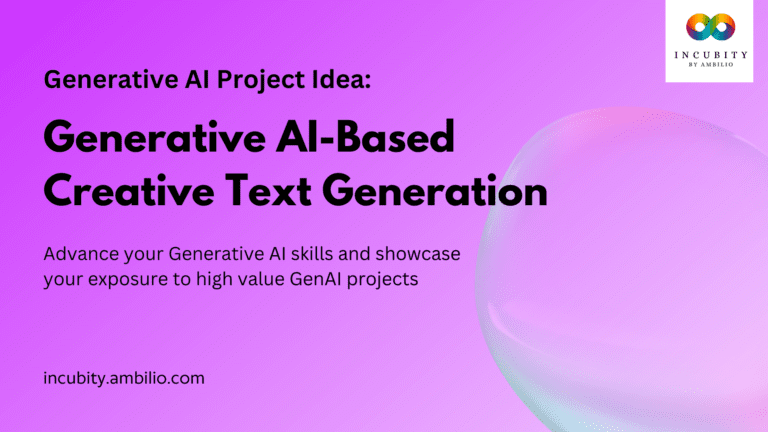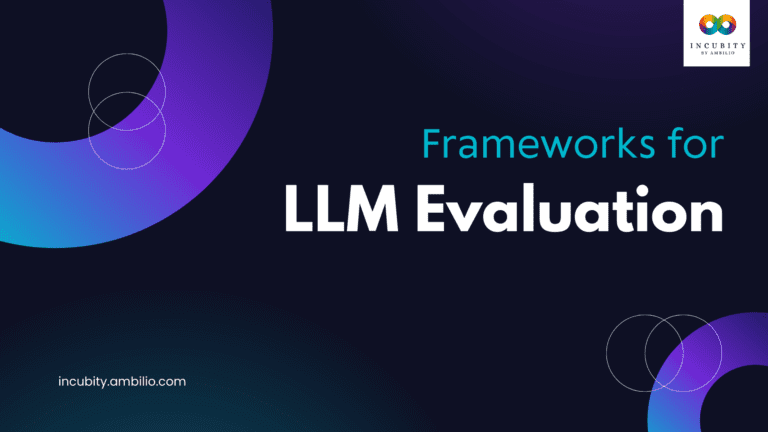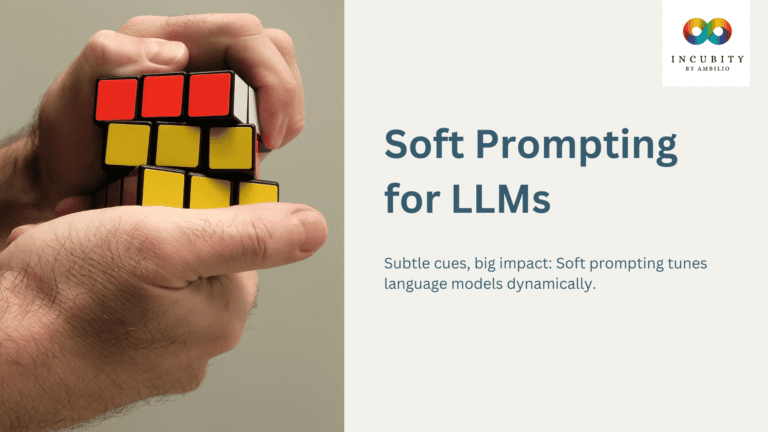In the rapidly evolving field of generative AI, the demand for professionals skilled in large language models (LLMs) is skyrocketing. As organizations harness the power of LLMs to create human-like text and drive innovation across various industries, the need for individuals well-versed in LLM technologies is at an all-time high. This guide serves as a vital resource for aspiring candidates looking to excel in LLM-based roles, offering a comprehensive understanding of the fundamental principles, advanced techniques, and practical applications of large language models. Through a detailed analysis of the top 20 LLM interview questions, readers can gain valuable insights and prepare effectively for success in this dynamic and promising field.
Top LLM Interview Questions
What is a large language model?
A large language model represents the pinnacle of natural language processing in artificial intelligence. It is a sophisticated neural network-based model that has undergone extensive training on massive datasets comprising diverse text sources, ranging from literature and news articles to social media posts and scientific papers. Through this training, the model learns the intricate patterns, nuances, and structures of human language, enabling it to generate coherent and contextually relevant text based on the input it receives.
Can you explain the difference between a parametric and a non-parametric language model?
Parametric language models are characterized by a fixed set of parameters that define the model’s architecture and capacity. In contrast, non-parametric language models possess a dynamic parameter space that expands or contracts based on the complexity of the input data. This flexibility allows non-parametric models to adapt to a wider range of linguistic contexts and variations, making them more versatile in handling diverse language tasks.
What is the Transformer architecture?
The Transformer architecture represents a groundbreaking paradigm shift in natural language processing, as introduced in the seminal paper “Attention is All You Need.” Unlike traditional recurrent neural network (RNN) architectures, Transformers rely on self-attention mechanisms to capture long-range dependencies and relationships within input sequences. This attention mechanism enables Transformers to process input data in parallel, significantly reducing training time and improving performance on a myriad of language tasks.
What is the role of attention mechanisms in large language models?
Attention mechanisms play a pivotal role in large language models by allowing the model to selectively focus on relevant parts of the input sequence when generating output. By dynamically weighing the importance of different tokens within the input sequence, attention mechanisms enable the model to effectively capture and integrate contextual information, facilitating more accurate and contextually coherent text generation.
How do you handle bias in language models?
Bias mitigation in language models is a multifaceted challenge that requires careful consideration and proactive measures. One approach involves curating training datasets to ensure diversity and representativeness across demographic, cultural, and linguistic dimensions. Additionally, techniques such as data augmentation, adversarial training, and debiasing algorithms can help mitigate biases inherent in training data. Post-processing methods, such as bias-aware evaluation metrics and fairness constraints, further contribute to fostering fairness and equity in language model outputs.
What is fine-tuning in the context of language models?
Fine-tuning refers to the process of adapting a pre-trained language model to a specific downstream task or domain by further training it on task-specific data. This approach leverages the knowledge and representations learned by the pre-trained model during its initial training on large-scale corpora, allowing for more efficient and effective learning on task-specific datasets. Fine-tuning enables language models to achieve state-of-the-art performance across a wide range of language tasks, including text classification, sentiment analysis, and machine translation.
How do you evaluate the performance of a language model?
Evaluating the performance of language models encompasses a diverse array of metrics and methodologies tailored to specific language tasks and applications. Common evaluation metrics include perplexity, a measure of the model’s predictive uncertainty; BLEU score, used for assessing machine translation quality; ROUGE score, employed in text summarization tasks; and human evaluation, which solicits subjective judgments from human annotators to assess the quality, coherence, and fluency of generated text.
Can you explain how reinforcement learning with human feedback can be used to fine-tune a language model?
Reinforcement learning with human feedback represents a novel approach to fine-tuning language models by incorporating human judgments and preferences into the training process. This paradigm involves training the model to generate text that maximizes a predefined reward signal, which is based on feedback provided by human annotators or evaluators. Through iterative cycles of text generation and human feedback, the model learns to align its output with human expectations and preferences, thereby enhancing its performance and adaptability across diverse linguistic contexts and tasks.
What is the role of tokenization in language models?
Tokenization serves as a fundamental preprocessing step in language modeling, wherein raw text input is segmented into individual tokens or subword units for computational processing. By breaking down input sequences into discrete tokens, tokenization enables language models to effectively encode and represent the underlying linguistic structure and semantics, facilitating more robust and efficient text generation and comprehension.
How do you handle out-of-vocabulary words in language models?
Out-of-vocabulary (OOV) words pose a common challenge in language modeling, particularly when encountering rare or unseen terms during inference. To address this challenge, language models employ various techniques, such as subword tokenization and character-level modeling. Subword tokenization algorithms, such as Byte Pair Encoding (BPE) and WordPiece, dynamically segment words into smaller subword units based on their frequency and contextual relevance, enabling the model to handle OOV words more effectively.
What is the difference between a language model and a sequence-to-sequence model?
While both language models and sequence-to-sequence models operate within the realm of natural language processing, they serve distinct purposes and exhibit different architectural characteristics. A language model focuses on predicting the next token or word in a given sequence, essentially modeling the probability distribution of sequential data. In contrast, a sequence-to-sequence model, also known as an encoder-decoder architecture, maps an input sequence to an output sequence, making it well-suited for tasks such as machine translation, text summarization, and dialogue generation.
How does beam search work in language models?
Beam search represents a popular decoding strategy employed in language generation tasks, such as text generation and machine translation. At its core, beam search operates by iteratively expanding a set of candidate sequences, known as the beam, and selecting the most promising candidates based on a predefined scoring criterion. By exploring multiple potential sequences in parallel and retaining a fixed number of top candidates (the beam width), beam search enables language models to generate coherent and contextually relevant text while balancing between exploration and exploitation.
What is zero-shot learning, and how does it differ from one-shot learning?
Zero-shot learning and one-shot learning represent two distinct paradigms within the realm of machine learning, each characterized by its approach to handling unseen or limited training data. Zero-shot learning entails training a model to perform tasks for which it has not been explicitly provided with labeled examples or training data. This is achieved by leveraging prior knowledge or transfer learning from related tasks or domains. In contrast, one-shot learning involves training a model on a single example or a small number of labeled instances for a given task, thereby enabling the model to generalize and make predictions based on limited data.
What are some challenges in training large language models?
Training large language models poses several formidable challenges, spanning data acquisition, computational resources, model interpretability, and ethical considerations. Acquiring high-quality, diverse and representative training data is paramount, as it directly impacts the model’s performance and generalization capabilities. Moreover, the computational resources required for training and fine-tuning large language models are substantial, necessitating access to high-performance computing infrastructure and specialized hardware accelerators, such as graphics processing units (GPUs) or tensor processing units (TPUs).
Interpreting and controlling the behavior of large language models pose additional challenges, as their complex architectures and massive parameter spaces make it challenging to discern how individual decisions are made or to diagnose errors and biases. Furthermore, ethical considerations surrounding issues such as fairness, transparency, and accountability are of utmost importance, requiring careful attention to mitigate potential harms and ensure responsible AI development and deployment.
How do you handle long-term dependencies in language models?
Long-term dependencies, wherein distant tokens in a sequence exhibit significant interdependence, pose a fundamental challenge in language modeling. To address this challenge, language models leverage specialized architectural components, such as attention mechanisms and recurrent neural networks (RNNs). Attention mechanisms enable the model to selectively attend to relevant tokens across long input sequences, facilitating more effective information propagation and context integration. Similarly, RNNs, particularly variants such as Long Short-Term Memory (LSTM) networks and Gated Recurrent Units (GRUs), are adept at capturing temporal dependencies and preserving information over extended sequences, thereby enhancing the model’s ability to handle long-range contextual relationships.
What is retrieval-augmented generation, and how does it differ from traditional language generation?
Retrieval-augmented generation represents an innovative approach to language generation that incorporates information retrieval techniques to enhance the quality and relevance of generated text. In traditional language generation, models generate text solely based on the input prompt or context, often relying on learned representations and generative algorithms. In contrast, retrieval-augmented generation involves retrieving relevant documents or passages from a large corpus of text, such as a knowledge base or an external dataset, and incorporating this retrieved information into the text generation process. By leveraging external knowledge and context, retrieval-augmented generation enables language models to produce more coherent, informative, and contextually relevant text outputs.
Can you give an example of a task where zero-shot learning might be useful, and explain why?
Zero-shot learning finds application in scenarios where the availability of labeled training data for all possible classes or tasks is limited or impractical. For instance, consider the task of sentiment analysis for customer reviews in a rapidly evolving industry, where new product categories or features emerge frequently. In such cases, training a sentiment analysis model on labeled data for every new product category or feature may be impractical or resource-intensive. Instead, zero-shot learning allows the model to generalize from existing labeled data for related product categories and adapt to new categories without the need for additional labeled examples. By leveraging shared semantic similarities and transfer learning, zero-shot learning enables the model to make accurate predictions for unseen or novel classes, thereby enhancing its scalability and adaptability in dynamic environments.
What is the difference between a generative and a discriminative language model?
Generative and discriminative language models represent two fundamental approaches to modeling the underlying probability distribution of input data. A generative language model focuses on modeling the joint distribution of both the input features and the target labels, enabling it to generate new samples from the learned distribution. In contrast, a discriminative language model directly models the conditional distribution of the target labels given the input features, facilitating tasks such as classification and prediction without explicitly modeling the entire data distribution. While generative models offer greater flexibility and versatility in capturing complex data dependencies and generating novel samples, discriminative models often exhibit superior performance and efficiency in tasks requiring direct inference or classification.
How do you handle overfitting in language models?
Overfitting, whereby a model learns to memorize training data rather than generalize to unseen examples, is a common challenge in language modeling. To mitigate overfitting, language models employ various regularization techniques, such as dropout, weight decay, and early stopping. Dropout randomly deactivates a fraction of neurons during training, preventing the model from relying too heavily on specific features or patterns. Weight decay imposes penalties on large parameter values, discouraging overly complex model configurations. Additionally, early stopping terminates training when the model’s performance on a validation dataset begins to deteriorate, thereby preventing further overfitting. By employing these regularization strategies, language models can strike a balance between model complexity and generalization performance, effectively mitigating the risk of overfitting and improving robustness across diverse datasets and tasks.
What is the role of reinforcement learning in language models?
Reinforcement learning offers a principled framework for training language models to optimize complex objectives and generate high-quality text outputs. By formulating text generation as a sequential decision-making process, reinforcement learning enables language models to learn optimal policies that maximize cumulative rewards over time. In the context of language modeling, reinforcement learning can be employed to fine-tune pre-trained models, adapt model behavior to specific tasks or domains, and optimize text generation strategies based on user feedback and preferences. By integrating reinforcement learning with traditional supervised learning and unsupervised learning techniques, language models can achieve state-of-the-art performance across a wide range of natural language processing tasks, including machine translation, dialogue generation, and summarization.
Final Words
In conclusion, as the field of generative AI continues to flourish and the demand for LLM professionals surges, mastering the intricacies of large language models becomes increasingly imperative. This guide serves as a beacon for those seeking to navigate the complexities of LLM-based roles, offering a roadmap to success in an ever-expanding landscape of artificial intelligence. By dissecting the top 20 LLM interview questions, this resource equips individuals with the knowledge, skills, and confidence needed to excel in harnessing the transformative potential of large language models. Embracing innovation and staying abreast of emerging trends, aspiring LLM professionals can carve out a rewarding career path at the forefront of AI-driven linguistic advancements.

